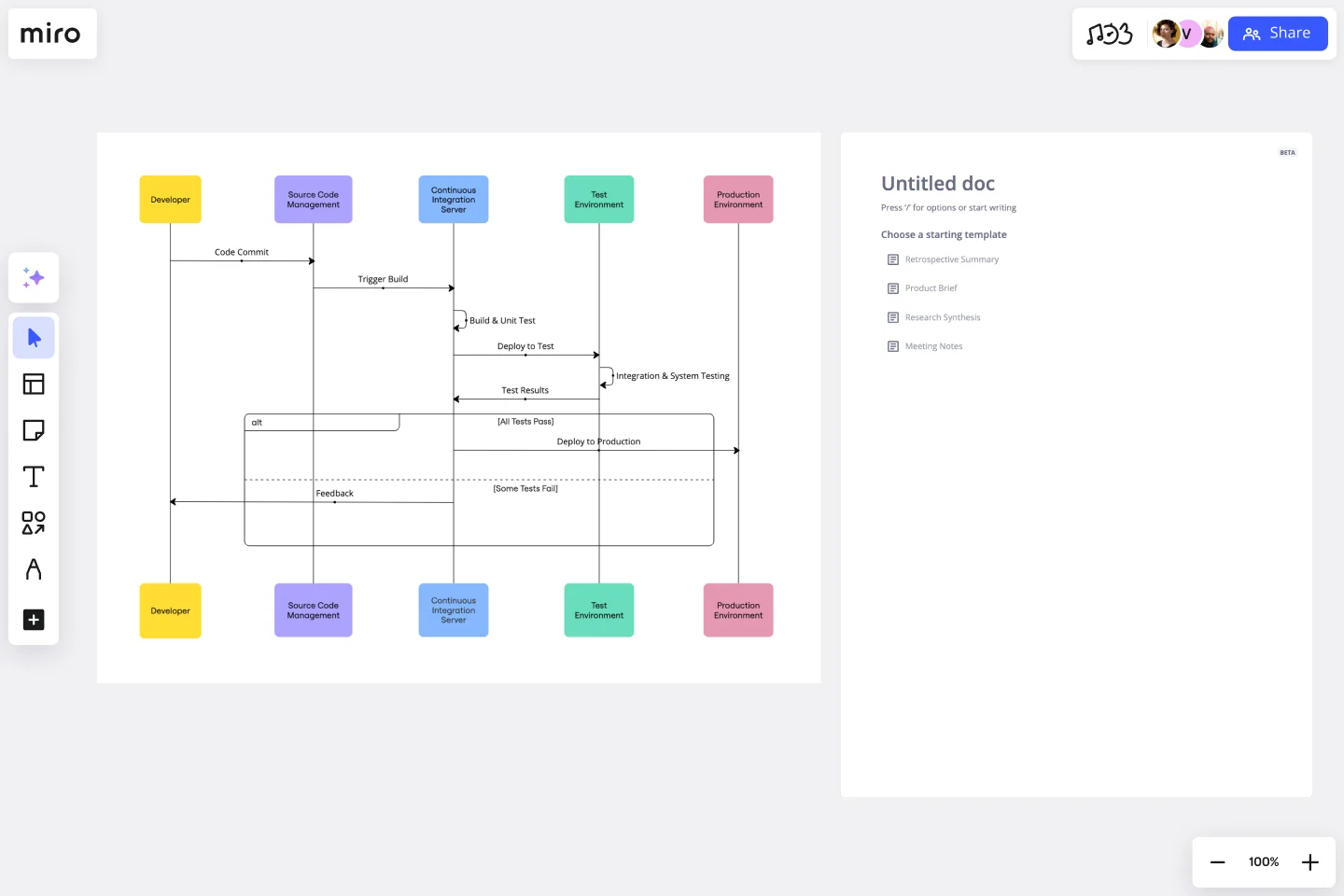UML Sequence Deployment Pipeline Template
Reduce the risk of deployment failures and support the standardization of deployment processes across projects or teams with the UML Sequence Deployment Pipeline Template.
Available on Enterprise, Business, Education plans.
About the UML Sequence Deployment Pipeline Template
The UML Sequence Deployment Pipeline Template is a tool designed to visualize the sequence of steps in an automated deployment pipeline. This template helps illustrate the flow from code commit through the build, test, and deploy stages. It serves as a visual representation, making it easier to understand the interactions and processes involved in deploying software. By mapping out these steps, teams can ensure a smooth and efficient workflow, identifying potential bottlenecks or issues in the deployment process.
How to use the UML Sequence Deployment Pipeline Template
Edit the template: Once the template is on your board, you can customize it according to your project's needs. You can modify the template using UML shapes and features or even create a diagram from scratch.
Collaboration: Invite team members to collaborate on the diagram by sharing the board with them. Team members can provide real-time feedback, make edits, and contribute to the deployment pipeline planning.
Integration and automation: Use Miro's integration features, such as Miro AI or text-to-diagram apps like PlantUML and Mermaid, to automate parts of the diagram creation or enhance the template with additional data.
Why use the UML Sequence Deployment Pipeline Template
The UML Sequence Deployment Pipeline Template is an invaluable resource for teams involved in software development and deployment. Here are several reasons to use this template:
Clarity and understanding: It provides a clear and detailed visual representation of the deployment process, making it easier for team members to understand the sequence of actions and their roles.
Efficiency: By visualizing the deployment pipeline, teams can identify and address inefficiencies or bottlenecks, streamlining the deployment process.
Collaboration: The template fosters collaboration among team members, allowing for a shared understanding and collective input on the deployment strategy.
Risk reduction: The template helps in reducing the risk of deployment failures by allowing teams to preemptively identify and mitigate potential issues in the deployment process.
Documentation and standardization: It serves as a form of documentation that can be used to standardize the deployment process across different projects or teams within an organization.
Training and onboarding: The template acts as a valuable educational tool for new team members, providing a clear overview of the deployment process and facilitating quicker onboarding.
Continuous improvement: By visualizing the deployment pipeline, teams can continuously identify areas for improvement, leading to more efficient and reliable deployments over time.
Get started with this template right now. Available on Enterprise, Business, Education plans.
Product tone of voice
Works best for:
Product Management, Planning
The Tone of Voice Workshop template helps product teams define and align on brand tone and messaging. By facilitating collaborative workshops, exploring brand personality traits, and defining tone guidelines, this template ensures consistent and impactful communication. With sections for identifying target audience personas, articulating brand values, and crafting messaging principles, it enables teams to create authentic and compelling brand voices. This template serves as a foundation for building strong brand identities and resonating with customers across all touchpoints.
Working Backwards Template
Works best for:
Desk Research, Strategic Planning, Product Management
Find out how to use the Working Backwards template to plan, structure, and execute the launch of a new product. Using the template, you’ll figure out if the product is worth launching in the first place.
Low-Fidelity Prototype Template
Works best for:
Design, Desk Research, Wireframes
Low fidelity prototypes serve as practical early visions of your product or service. These simple prototypes share only a few features with the final product. They are best for testing broad concepts and validating ideas. Low fidelity prototypes help product and UX teams study product or service functionality by focusing on rapid iteration and user testing to inform future designs. The focus on sketching and mapping out content, menus, and user flow allows both designers and non-designers to participate in the design and ideation process. Instead of producing linked interactive screens, low fidelity prototypes focus on insights about user needs, designer vision, and alignment of stakeholder goals.
5-Set Venn Diagram
Works best for:
Venn Diagram
Analyze complex data with the 5 Set Venn Diagram template. This tool allows you to compare and contrast five different sets of data, highlighting intersections and unique elements. Perfect for in-depth data analysis, research, and strategic planning. Ideal for analysts, researchers, and educators looking to present comprehensive data insights in a clear and visual manner.
Precedence Diagram
Works best for:
Diagramming, Mapping
The Precedence Diagram Template offers a visual tool that maps out project activities and their interrelated sequences. This diagram empowers teams to recognize and anticipate workflow structures by illustrating the connections and dependencies among tasks.
Product Vision Statement
Works best for:
Product Management, Planning
The Product Vision Statement template helps product teams articulate clear and inspiring visions for product development. By defining long-term goals, market aspirations, and customer value propositions, this template aligns teams around a shared vision for success. With sections for outlining strategic objectives, guiding principles, and success metrics, it provides clarity and direction for product development efforts. This template serves as a compass for product teams, guiding them towards meaningful outcomes and driving innovation and growth.
